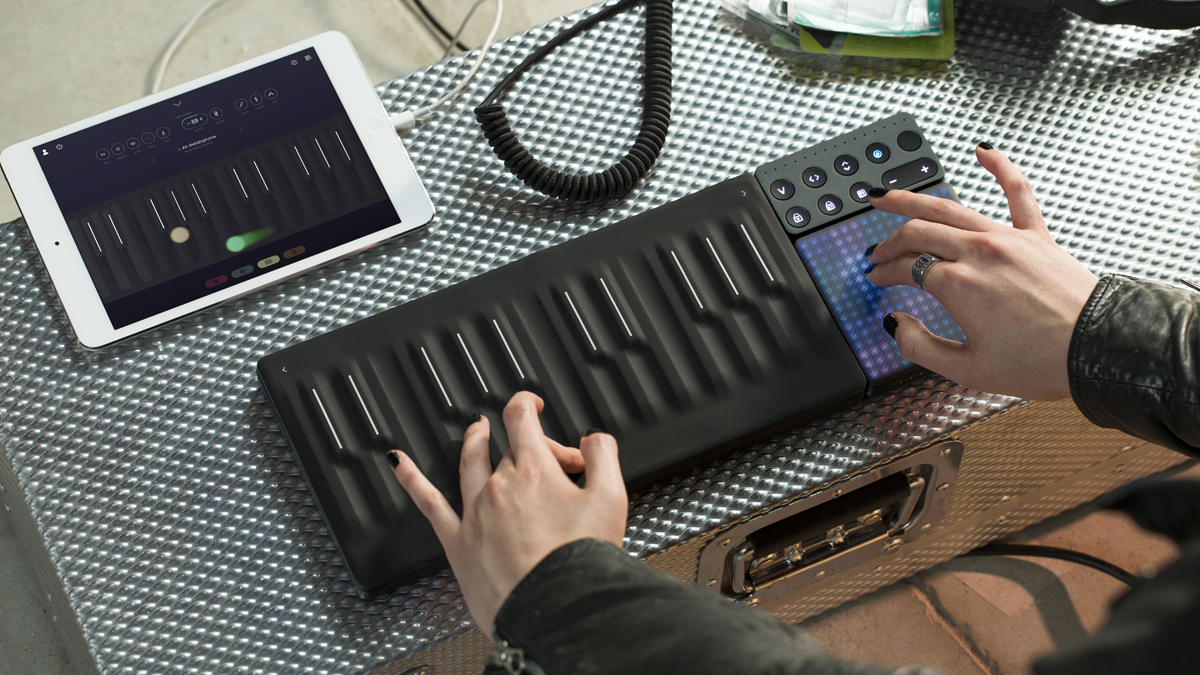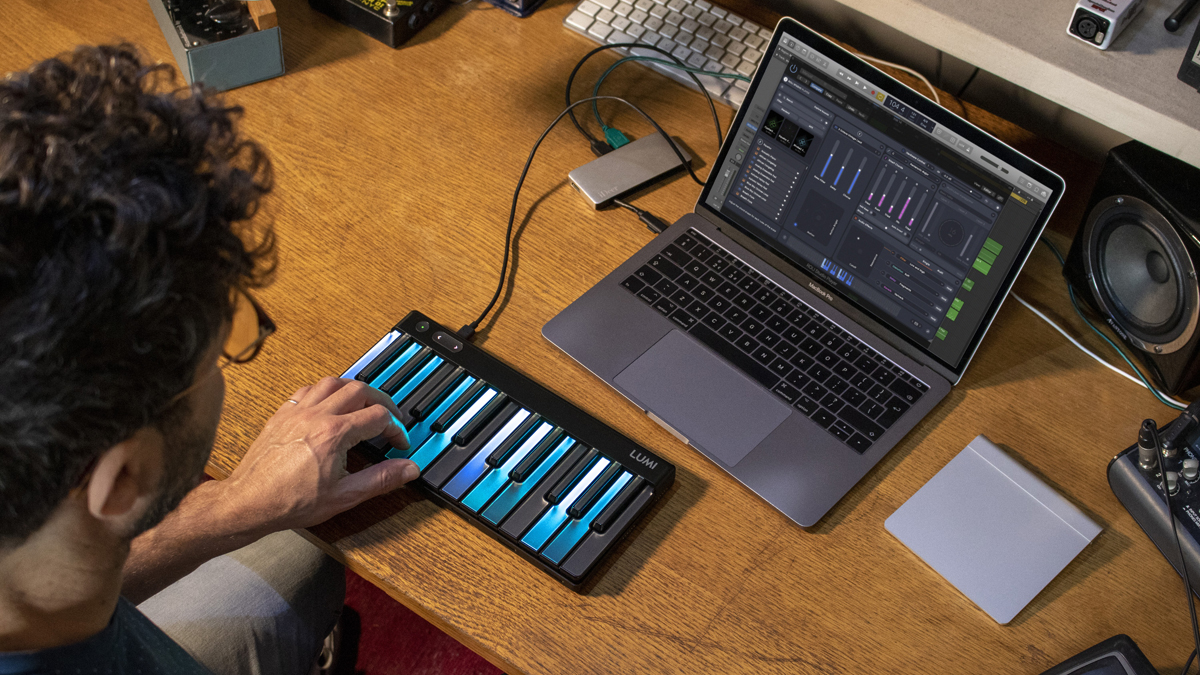MusicRadar Verdict
Bright, forward-thinking and admirably ambitious, the studio version of ROLI’s illuminated controller is ultimately let down by its most appealing feature.
Pros
- +
Illuminated keys are genuinely useful and look brilliant.
- +
Fantastic true polyphonic aftertouch.
- +
4D MPE functionality.
- +
Useful plugin bundle.
Cons
- -
Disappointing pitchbend implementation.
- -
Tricky to set up.
- -
No sustain pedal input.
- -
Bluetooth needs to be paired each use.
MusicRadar's got your back
What is it?
On the back of a successful Kickstarter campaign in 2019, ROLI released the original LUMI Keys illuminated keyboard as an educational aid to make learning to play the keyboard a fun and interactive pursuit.
Following a significant firmware update in January 2021, LUMI Keys is now available in two flavours - LUMI Keys 1 is the original education-focussed version, with access to the LUMI App and LUMI Essential content. This includes 40 classic songs, 60-odd lessons and 72 exercises.
Meanwhile, with clear focus on features such as polyphonic aftertouch, light-guided composition and the much-anticipated per-key pitch bend, LUMI Keys Studio Edition is the professional offering, and comes with the ROLI Studio Player and ROLI Studio Drums plugins.
Hardware controls on the LUMI are kept to a minimum. There's an on/off switch that doubles as a mode selector button, plus a pair of octave shift buttons. There’s no sustain pedal input and the LUMI lacks conventional pitch and mod wheels, presumably due to the expressive control available via the keys themselves. Also in the box is a handy snap case, which doubles as a tablet stand if using the LUMI app for lessons.
Weighing in at a backpack-friendly 600 grams, the unit feels solid and well-constructed, and a thin rubber surround on the base secures the LUMI to your desktop very effectively, ensuring it won’t move around while you’re playing.
ROLI seems to have worked hard to overcome some of the build quality issues that emerged during the product’s Kickstarter rollout. The most apparent change is the absence of any magnetic DNA connectors on the rear of the unit, used to dock with additional LUMIs and other ROLI BLOCKS products. The company confirms these have been removed in order to improve the stiffness of the chassis.
The connectors on the left and right edges remain, however, so you can link two or more LUMIs together magic-netically to create a seamless, expanded playing surface.
Want all the hottest music and gear news, reviews, deals, features and more, direct to your inbox? Sign up here.

Studio Player’s Smart Chords feature that generates full chords from single note input is nothing short of inspirational, especially if dance music is your thing.
Because the keyboard geometry is derived from the fixed size of ROLI’s Blocks product range, the keys themselves are narrower than on a standard piano keyboard at just 5.5” per octave. Although this makes the LUMI ideal for smaller hands, the drawback of this approach means that, if you can only stretch to a single LUMI, you don’t get a top C key, as the keyboard only spans C1-B3. Most other two-octave boards range from C1-C3, so the LUMI is technically only a 24-note keyboard.
The light-up keys themselves are a delight, rainbow-colourful and extremely bright (although you can dim the brightness if preferred in the ROLI Dashboard app), and offer studio-friendly functionality beyond merely learning how to play. For instance, Studio Player’s Smart Chords feature that generates full chords from single note input is nothing short of inspirational, especially if dance music is your thing. For each note of your chosen scale, you can choose from basic triads all the way up to extended chords like 11ths and 13ths by way of suspensions and automatically-selected inversions, any or all of which are displayed on the keyboard lights as you play a single root note. This is very cool indeed, and a great way to learn new chord voicings.
Performance and verdict
That long-awaited recent firmware update added MPE control with per-note pitchbend and proper polyphonic aftertouch, promising to transform the LUMI Keys from an educational tool into an MPE-enabled controller with a typical keyboard form factor. Unlike the five dimensions of touch offered by ROLI’s Seaboard range of controllers, however, the LUMI only offers 4 dimensions - Glide, Strike, Press and Lift.
The keyboard feels a little plasticky under the fingers, and the key travel seems oddly shallow, but although not the nicest we’ve ever played, it is functional. The polyphonic aftertouch works especially well, offering a good degree of control over individual notes within chords, through a judicious amount of definable sponginess after the initial keystroke. It’s extremely responsive, and, unlike some regular keyboards, doesn’t need to be leant on with excessive pressure in order to elicit a response. The response curve can be freely edited in the ROLI Dashboard app too, so you can personalise its behaviour to taste.
Confusingly, however, when using the device with ROLI’s own Studio Player app, pitchbend range is limited to one semitone. We also experienced occasional intermittent triggering, with some black keys refusing to output the odd note-on message, particularly when playing faster passages. We get the impression that the LUMI is more tailored towards slower, more expressive playing styles than our fast, funky fingering style.
On the educational front, the LUMI iPad app which connects via Bluetooth is expertly executed, with plenty of video content woven into a stylish interface design, inspiring our keyboard-agnostic teenage test subject to play Gymnopedie No.1 within an hour of powering on the device. The bundled LUMI Essential song lesson content is solely made up of classical and traditional tunes, but if you want more contemporary material, you can opt for the LUMI Complete subscription that offers over 500 songs, more than 130 lessons and 380 exercises.
Although the 24-key limit restricts learning to one-handed parts only, the Watch-Practise-Challenge learning formula, together with the video-game style presentation of awards and challenges and a Netflix-style autocue of the next lesson, form an effective and addictive learning process.

• ROLI Seaboard Block
Blocks-sized version of ROLI’s rubbery Seaboard control surface. Similarly priced with no illumination, but you get the full 5D experience.
• CME Pro Xkey Air 25
Super-thin, aluminium-bodied Bluetooth MIDI keyboard with 25 full-size keys and polyphonic aftertouch.
All in all, then, LUMI Keys Studio Edition is a bit of a mixed bag. The styling is off the charts, the battery life is good, and those bright, colourful keys are fantastic for scale practice, creating visual social media content or performing on stage. There's a lot to like here, such as the true polyphonic aftertouch, MPE and Bluetooth features and the well-executed educational content when paired with the LUMI app. Most equivalent-sized keyboards will offer the full 25-key, two-octave range for much less money, however, so it really all comes down to the appeal of that extra layer of expressive control delivered by 4D touch.
Sadly, for us, the much-lauded bend-per-note feature falls some way short of our expectations. While it works okay for vibrato, the one-semitone limit in Studio Player is frankly odd, and setting up the required ranges for different VST synths was a convoluted affair.Match the pitch bend range in ROLI Dashboard to that in your chosen synth and you’ll get a one-semitone bend. Divide that number by two on the synth to get a two-semitone bend, by three for three semitones, etc. Even having figured that out, achieving the desired bluesy, guitar-style bends when soloing still eluded us, as we simply couldn’t move the keys far enough to the side to bring on the effect without jamming a thumbnail under the key’s left edge and pushing it to the right. We finally gave up when it started to bend notes down when we rolled to the right and vice versa.
ROLI products have always offered an innovative, likeable and refreshingly different approach to expressive control. While admirable, we still haven’t found one that stands out as an obvious replacement for a regular MIDi controller keyboard. That said, the 4D multitouch gesture experience is undoubtedly a worthwhile and useful thing to able to call on in the studio for certain applications, and, pitchbend issues notwithstanding, the LUMI Keys Studio Edition still offers a serviceable and relatively affordable way into the ROLI ecosystem.
MusicRadar verdict: Bright, forward-thinking and admirably ambitious, the studio version of ROLI’s illuminated controller is ultimately let down by its most appealing feature.
The web says
"Playing the LUMI is a joy - it’s very responsive, with no perceptible delay between pressing keys and hearing the notes. The only slight niggle is that, as the keys don’t travel all that far, it’s easy to accidentally trigger notes twice." T3
"Lumi aims to inspire and cultivate a love of music by making it easy to learn, play, and make music in a fun environment. This keyboard delivers on that promise." Tom's Hardware
Hands-on demos
ROLI
WasabiNoise
BrandonRico Simpson
Specifications
- TYPE: Wireless illuminated MPE-enabled MIDI keyboard controller
- KEY FEATURES: 24 keys with velocity, polyphonic aftertouch and per-key pitchbend
- CONTROLS: On/Off/Mode, Octave up/down buttons
- CONNECTIONS: ROLI DNA connectors x 4, Bluetooth
- CONTACT: ROLI
Dave has been making music with computers since 1988 and his engineering, programming and keyboard-playing has featured on recordings by artists including George Michael, Kylie and Gary Barlow. A music technology writer since 2007, he’s Computer Music’s long-serving songwriting and music theory columnist, iCreate magazine’s resident Logic Pro expert and a regular contributor to MusicRadar and Attack Magazine. He also lectures on synthesis at Leeds Conservatoire of Music and is the author of Avid Pro Tools Basics.

